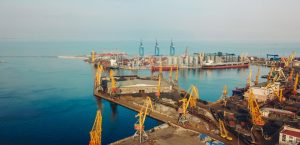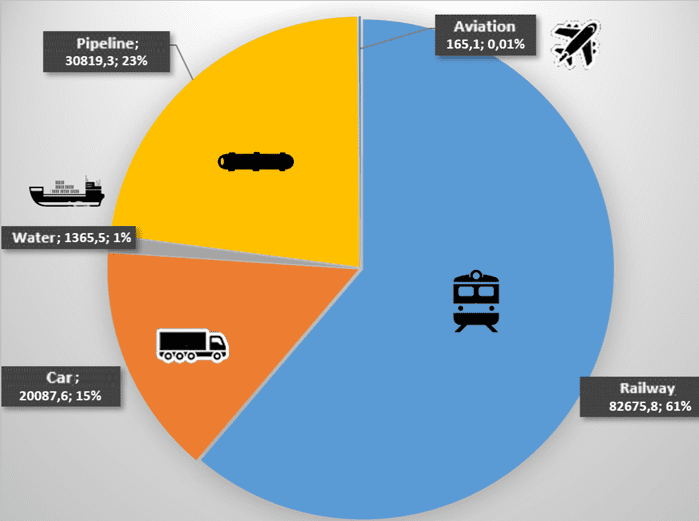
he seaports of Ukraine in January-August 2020, according to recent data, handled more than 105.77 million tonnes of cargo, which is 5% more compared to the same period in 2019.
According to information on the website of the Ukrainian Sea Ports Authority, transshipment of exported cargo increased to 80.8 million tonnes (5.4% more), imported cargo to 16.1 million tonnes (0.9% more), transit to 7.3 million tonnes (4.6% more), cabotage goods to 1.6 million tonnes (30.8% more).
Grain became the leader in terms of transshipment volumes for the specified period, the transshipment of which amounted to 30.7 million tonnes.
Ore ranked second with 30.2 million tonnes, which is 27.5% more than the same indicator of the previous year.
Pig iron transshipment increased by 49.8%, to 2.3 million tonnes, oil transshipment increased by 4.1%, to 4 million tonnes, crude oil by 2.5 times with a processing volume of 1.4 million tonnes over the specified period.
Transshipment of containers reached 690,600 TEU and exceeded the last year’s figure by 9.2%.
Volumes of cargo transportation in Jan-June of 2020, MLn tons


The construction of a cargo terminal at Boryspil International Airport (Kyiv region) is scheduled to begin this fall, the press service of the European Business Association (EBA) has said, following a meeting of Deputy Infrastructure Minister Oleh Yuschenko and airport representatives.
According to the EBA, with reference to the Ministry of Infrastructure, design work is currently underway to prepare for the construction of the cargo terminal, for which additional land plots have already been allocated. Provided that all preparatory work is completed on time, construction will begin in the fall and should be completed 16 months later.
“Thus, according to optimistic estimates, Boryspil airport will receive a new cargo terminal by the end of 2021,” the report says.
The association notes that the construction of the terminal will be carried out at the expense of attracted credit funds, which, according to representatives of Boryspil airport, have already been previously agreed upon. In turn, the Ministry of Infrastructure is negotiating, in particular, with Asian countries on attracting additional transit flows and is working on simplifying document flow.
“The business community approves such news, because logistics companies have long been awaiting the implementation of this project. The association’s logistics committee includes companies that transport goods, including by air, in international traffic and within Ukraine. Business representatives have a significant share in freight flow, which passes, in particular, through the cargo terminal of Boryspil airport,” the EBA said.
One of the main reasons that currently hinder the development of air cargo transportation in Ukraine, the association calls the worn-out infrastructure of the cargo terminal of Boryspil airport, since the structure of the terminal and its capacity have remained unchanged for many years. In this regard, problems regularly arise during the transportation of goods, especially in winter, when due to bad weather the airport cannot cope with the volume of load, the association explained.
 Volumes of cargo transportation in Jan-Apr of 2020, Mln tons
Volumes of cargo transportation in Jan-Apr of 2020, Mln tons

Mariupol seaport (Donetsk region) increased cargo handling by 23.4% in January-May 2020 compared to the same period in 2019, to 2.687 million tonnes.
According to the statement of the Ukrainian Sea Ports Authority on the state-owned enterprise’s website, during the period the port increased the transshipment of export cargo by 15.5%, to 2.238 million tonnes, import by 28.7%, to 303,620 tonnes, coastal freight by almost 56 times, to 145,100 tonnes. At the same time, the port did not handle transit cargo.
According to freight nomenclature, Mariupol seaport increased the transshipment of dry bulk cargo by 42.8%, to 827,700 tonnes, and packaged goods by 17.4%, to 1.783 million tonnes. At the same time, it reduced the transshipment of bulk cargo by 2.6%, to 76,000 tonnes.
As reported, the port handled 6.484 million tonnes of cargo in 2019, which is 10% more than in 2018.

In January-April 2020, the seaports of Ukraine handled more than 55 million tonnes of cargo, which is 12.6% more compared to the same period in 2019.
According to the statement of the Ukrainian Sea Ports Authority on the state-owned enterprise’s website, traditionally, the leaders in transshipment are grain and ore.
Over the indicated period 18.7 million tonnes (5% more) of grain and 13.8 million tonnes of ore (30.5% more) were handled.
Handling of coal doubled to 2.5 million tonnes and that of crude oil increased by five times to 800,000 tonnes. Transshipment of containers by Ukrainian ports amounted to 357,700 TEU (up by 17.2%).
According to the Sea Ports Authority, handling of exported cargo increased due to a rise in transshipment of grain to 18.2 million tonnes (by 5.3%), iron ore to 10.9 million tonnes (by 45.4%), oil to 2.2 million tonnes (by 8.8%).
Transshipment of imported cargoes increased due to a rise in handling coal to 2.3 million tonnes (by 106.9%) and crude oil to 500,000 tonnes (by 213.6%), and oil products to 400,000 tonnes (by 233.3%).
Transit transportations increase due to a rise in handling ore to 1.1 million tonnes (by 34%) and crude oil to 400,000 tonnes.
Four seaports led in terms of cargo handling: Pivdenny, Mykolaiv, Chornomorsk and Odesa. In general, they processed 47.7 million tonnes of cargoes, which is 87% of the total volume of cargo handling by Ukrainian seaports.